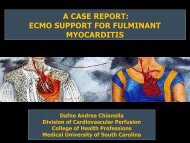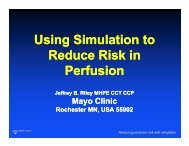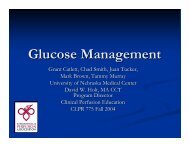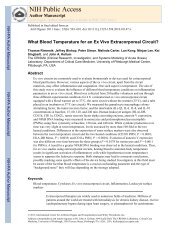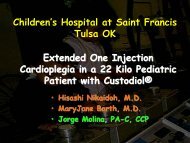PowerPoint Presentation (PDF) - Perfusion.com
PowerPoint Presentation (PDF) - Perfusion.com
PowerPoint Presentation (PDF) - Perfusion.com
Create successful ePaper yourself
Turn your PDF publications into a flip-book with our unique Google optimized e-Paper software.
VAD’s and Simulation:<br />
Can accidents be prevented di<br />
in<br />
an MCS program?<br />
David Fitzgerald, BS, CCP<br />
Chief of Cardiovascular <strong>Perfusion</strong><br />
INOVA Heart and Vascular Institute<br />
Falls Church, VA
Disclosures<br />
• Terumo Cardiovascular<br />
• Speaker- Honorarium<br />
• Focus Panel- Honorarium<br />
• Medtronic<br />
• Focus Panel- Honorarium
U.S. Airways Flight 1549
U.S. Flight 1549
“This is for the birds”<br />
• 1 out of every 7,000 flights<br />
encounters a bird strike.<br />
• Over 49,000 flights per day<br />
in the world<br />
• 25 million flights/year<br />
• 1.7 billion passengers/yr.<br />
• Only 7 other documented<br />
crashes from bird strikes in<br />
the history of aviation.<br />
Source: faa.<strong>com</strong>
Airline Industry<br />
•Pillars of Aviation<br />
•Standardization<br />
•Redundancy<br />
•Experience<br />
•Simulation
Flight Simulation
<strong>Perfusion</strong> Simulation
Simulation in Training<br />
• Offered when it is too dangerous or expensive<br />
to allow trainees to use real life “equipment”<br />
• Spend time learning valuable skills in a “safe”<br />
virtual environment.<br />
• Can permit mistakes during training i for a safety-<br />
critical system.<br />
• Avoid “learning on the job behaviors”<br />
-Wikipedia
Training Simulations<br />
• Training simulations <strong>com</strong>e in 3 categories<br />
• “Live” simulation: simulated equipment in the real<br />
world<br />
• “Virtual” simulation: simulated equipment in a<br />
virtual environment<br />
• “Constructive” simulation: simulated equipment in a<br />
simulated world.<br />
• War-gaming
Medical Errors in the Hospital<br />
“To Err is Human”- Institute of<br />
• 1.5 million estimated annual<br />
preventable hospital errors<br />
Medicine-1999<br />
• An estimated 98,000 patients die<br />
from medical errors.<br />
• > MVA’s, breast cancer, or AIDS.<br />
• IOM suggested that hospital<br />
errors should be reduced by 50%<br />
over 5 years.
Medical Simulation<br />
• High-fidelity virtual reality platforms<br />
• Rehearse high-risk skills<br />
• Even the most experienced clinicians can’t always anticipate a<br />
crisis event.<br />
• Develop valid teaching and evaluation tools<br />
• Bridge between classroom learning and real-life life clinical<br />
experience<br />
• May raise the bar for objectivity and fairness in evaluation.<br />
• Learning experiences can be customized.<br />
• Learn valuable lessons in a “safe” work environment<br />
• “Patient died. Oops. Let’s try again!”<br />
• Improve current quality of delivered d<br />
care<br />
• Opportunities to express needs to manufacturers
Medical Simulation (cont’d)<br />
• Medical simulation centers are expanding.<br />
• 161 current listings- Society for Simulation in Healthcare<br />
• Scope of services<br />
• Blood draws<br />
• Deliveries<br />
• Trauma<br />
• Surgical service<br />
• Prototyping new devices.<br />
• R & D for new therapies and treatments.
Government & Simulation<br />
Enhancing Safety<br />
In Medicine<br />
Utilizing<br />
Leading<br />
Advanced<br />
d Simulation<br />
i Technologies to Improve<br />
Out<strong>com</strong>es<br />
Now Act of 2009, H.R. 855<br />
• Amend public health service act to authorize medical<br />
simulation enhancement<br />
• Requires Director of the Agency for Healthcare<br />
Research h&Q Quality to enhance deployment of<br />
simulation technologies<br />
• Rf Referred dt to the House Committee on Energy and<br />
Commerce.
The Enhancing SIMULATION Act<br />
• Establish centers for excellence for simulation<br />
• Promote innovation<br />
• Research, evaluations, initiatives<br />
i i i<br />
• Award grants for deploying technologies<br />
• Funding for:<br />
• Medical, Nursing, Allied Health, Podiatry,<br />
Osteopathic medicine, Dental
Heart Failure<br />
• 4.9 million people affected in U.S., 25 million in the<br />
world.<br />
• 550,000 new cases diagnosed every year<br />
• More hospital ld days are spent for heart failure than any<br />
other diagnosis.<br />
• Heart transplantation is the standard of care<br />
• Available donor hearts/yr.- approx. 2100<br />
• Survival outlook
• > 65 and over<br />
• 348,000 in 1980<br />
Heart Failure<br />
• 807,000 in 2006 (131% increase)<br />
• 2002-2006: 2006: Relative risk of hospitalization was 1.37<br />
times higher than 1980-19841984<br />
• Heart Failure expected to reach $34 billion in 2009.<br />
• Over the next decades, the number of U.S. adults age<br />
65 and older will double to a projected 70 million, and<br />
more than one in five will be 65 or older by the year<br />
2030.
History of Ventricular Assist Devices<br />
• Over 25 years and counting.<br />
• Approximately 1/3 of patients with VAD implanted as<br />
a BTT will not survive to transplantation<br />
• Multi-organ failure<br />
• Infection<br />
• RV failure<br />
• Bleeding<br />
• Patient selection and pre-op preparation are key<br />
ingredients for successful out<strong>com</strong>es.<br />
• Infection control and nutrition.
Evolution of Mechanical Assist
In 1994……..<br />
Nancy Kerrigan…Meet<br />
Tonya Harding<br />
World Series cancelled
In 1994……..<br />
The Juice is Loose!<br />
U.S. Gross Debt- 4.6 trillion<br />
2009 Gross Debt- 10.6 trillion
In 2009......
Ventricular Assist Devices<br />
• Functional Recovery<br />
• Abiomed, Centrimag, ECMO<br />
• Bridge to Transplantation<br />
• PVAD/IVAD, Heartmate XVE, HMII, Novacor,<br />
Jarvik, DeBakey<br />
• Destination Therapy<br />
• Heartmate XVE<br />
• Total Artificial Hearts<br />
• CardioWest, Abiocor
• Registry launched June<br />
2006<br />
• Retrospective and<br />
prospective collection<br />
• 1682 patients enrolled<br />
• 98 activated hospitals<br />
• 95 centers entered at<br />
least 1 patient<br />
• 57 CMS certified<br />
destination therapy<br />
centers<br />
INTERMACS ® Registry<br />
Center Enrollment
INTERMACS ® Registry Patient Enrollment<br />
(3/1/2006-3/31/2009) 3/31/2009)
INTERMACS ® Registry Patient<br />
Demographics<br />
(3/1/2006-3/31/2009) 3/31/2009)<br />
800<br />
700<br />
600<br />
500<br />
400<br />
300<br />
200<br />
100<br />
0<br />
48<br />
729<br />
453<br />
245<br />
Patient Age at Implant<br />
1<br />
0-18<br />
19-39<br />
40-59<br />
60-79<br />
80+
Trends in Heart Transplants (UNOS: 1975-2006).<br />
Source: United Network for OrganSharing (UNOS), scientific<br />
registry data.<br />
Number of Trans plants<br />
2,500<br />
2,000<br />
1,500<br />
1,000<br />
500<br />
0<br />
22 57<br />
719<br />
2,363<br />
2,107 2,199 2,192<br />
75 80 85 90 95 00 06<br />
Years
REMATCH Study<br />
• Randomized Evaluation of Mechanical Assistance<br />
for the Treatment of Congestive Heart Failure<br />
• Chronic heart failure patients, NYHA Class IV, not<br />
eligible ibl for transplantation<br />
t ti<br />
• Heartmate XVE vs. optimal medical management<br />
• 48% reduction in death vs. OMM<br />
• Quality of life improved vs. OMM<br />
• 2002- FDA approved XVE as long-term<br />
destination therapy device<br />
• Reimbursement from CMS for DT applications
Destination Therapy
INTERMACS ® Registry Patient Survival<br />
(6/23/2006-3/31/2009) 3/31/2009)
Can We Improve Out<strong>com</strong>e??<br />
• FDA Database<br />
• M.A.U.D.E. (Manufacturer & User Facility Device<br />
Experience)<br />
• Reports of adverse events involving medical<br />
devices.<br />
• User facility reports (voluntary)- 1991<br />
• Distributor ib reports- 1993<br />
• Manufacturer reports- 1996
Reported VAD Events<br />
• Since 1996:<br />
• 863 reported events<br />
• 579 pump malfunctions<br />
• 250 patient injuries<br />
• 77 patient t deaths<br />
* Thoratec, Abiomed, Jarvik, TCI, Syncardia,<br />
Novacor, Ventracor, Heartware, Levitronix,<br />
TandemHeart, Debakey Micromed.
• Expanding technology<br />
VAD Simulation<br />
• More patients are eligible-DT gb therapy<br />
• Number of available organs has peaked<br />
• Eliminate the “Boutique” model of training<br />
• See one, do one, teach one<br />
• Low volume / high risk procedures<br />
• Most critically-ill ill patients on service<br />
• # of available devices is expanding<br />
• Newer generation devices operate differently than<br />
previous models, more durable.<br />
• 2 year vs. 10 year length of support
VAD Simulation (cont’d)<br />
• VAD training is often relied upon by the<br />
manufacturer.<br />
r<br />
• VAD physiology is “counter-intuitive” to<br />
conventional medicine<br />
• Pulse-less less devices (valve-free, laminar flow)<br />
• No CPR for cardiac arrest<br />
• No EKG- TAH<br />
• Joint Commission<br />
• DT therapy certification for MCS programs<br />
• Disease-specific specific care for MCS patients
If you Build it, They will Come!<br />
# of MCS Patients at INOVA<br />
40<br />
35<br />
30<br />
25<br />
20<br />
15<br />
10<br />
5<br />
0<br />
1989 1990 1991 1992 1993 1994 1995 1996 1997 1998 1999 2000 2001 2002 2003 2004 2005 2006 2007 2008
Modern Orchestra
Modern Orchestra
Modern Orchestra<br />
1. Violins 6. Flutes 11. Trumpets<br />
2. 2nd Violins 7. Oboes 12. Trombone<br />
3. Violas 8. Clarinets 13. Timpani<br />
4. Cellos 9. Bassoons 14. Harp<br />
5. 2nd Basses 10. Horns
Mechanical Assist Program<br />
1. Surgeon 6. Blood Bank 11. Social Worker<br />
2. VAD Coord.<br />
7. ICU RN 12. P.T.<br />
3. <strong>Perfusion</strong> 8. Intensivist<br />
13. Administration<br />
4. Anesthesia 9. Bio-Med<br />
14. EMS / Hospice<br />
5. O.R. RN 10. Telemetry RN
VAD Simulation<br />
• VAD Coordinators<br />
• <strong>Perfusion</strong><br />
• ICU / Telemetry RN’s<br />
• Bio-engineers<br />
• Physicians<br />
• Social Workers<br />
• EMS/First responders<br />
r<br />
• Hospice caregivers
Case Scenario #1<br />
(Surgeon)<br />
Patient that received a 4-vessel CABG did not successfully<br />
wean from lengthy CPB support. Suspecting an intra-<br />
operative MI, the surgeon decided to perform an Abiomed<br />
RVAD insertion. After the insertion and a successful wean<br />
from CPB, the surgeon lifted the heart to inspect for bleeding<br />
at the anastomosissite. site. During lifting, i the side holes of the<br />
atrial cannula were exposed and air was introduced to the<br />
VAD pump.<br />
- Air embolism emergencies
Case Scenario #2<br />
(Scrub Nurse)<br />
During a Centrimag LVAD insertion in the operating room<br />
the perfusionist hands the primed sterile lines to the field for<br />
connection to the catheter. The surgeon asks for inflow<br />
tubing and outflow tubing, respectively. The scrub nurse<br />
accidentally hands the lines up in reverse order. After the<br />
cessation of CPB and the VAD is started, the surgeon notices<br />
the heart acutely swell and the arterial pressure plummet. The<br />
surgeon asks the perfusionist to increase the VAD flow to off-<br />
load the ventricle. The condition worsens, forcing the re-<br />
initiation of CPB support.<br />
- Table lines reversed, flow path Ao-LV.
Case Scenario #3<br />
(Caregiver)<br />
Patient is on HMII support and is seemingly making steady<br />
progress on the telemetry floor. Discharge orders are being<br />
written by the P.A. During the interview the patient<br />
<strong>com</strong>plains of new-onset lethargy and a weakened appetite.<br />
The P.A. determines that the pump flow is less than normal<br />
and decides to increase the pump speed by 400 RPM, resulting<br />
in an much improved C.I. The P.A. leaves after the consult.<br />
Moments later, the patient de-<strong>com</strong>pensates and cardiac arrest<br />
ensues.<br />
Ventricular suck-down; quick RPM changes
Case Scenario #4<br />
(Paramedic)<br />
EMS providers respond to a call of a Heartmate XVE patient<br />
in distress. Patient’s chief <strong>com</strong>plaint is dizziness. Upon<br />
arrival, EMS providers attach an ECG monitor and quickly<br />
reveal lth the patient ti is in v-tach<br />
tach. The paramedics attempt t to<br />
defibrillate the patient and in doing so short circuit the system<br />
controller. The pump stops and hand-pumping is now<br />
necessary to maintain support.<br />
Disconnect system monitor before cardioversion;<br />
handpumping p and/or system controller change-out required
Case Scenario #5<br />
(Patient)<br />
A newly discharged D.T. patient with a Heartmate<br />
XVE ac<strong>com</strong>panies his wife to see a movie at the<br />
theater. The length of the movie is 2.5 hours,<br />
short enough for him to see the movie under 1<br />
set of batteries. He decides to leave his extra<br />
batteries and hand pump in the car. After the<br />
movie he realizes their car was stolen. He has<br />
approximately 45 minutes of charge left on his<br />
current set.
Conclusions<br />
• Simulation is paramount in 21 st century medical<br />
training programs.<br />
• The number of MCS patients continues to<br />
increase.<br />
• Simulation i could offer valuable lesson-learned<br />
learned<br />
experiences to MCS caregivers.<br />
• Could simulation prevent VAD accidents?
Thank You



